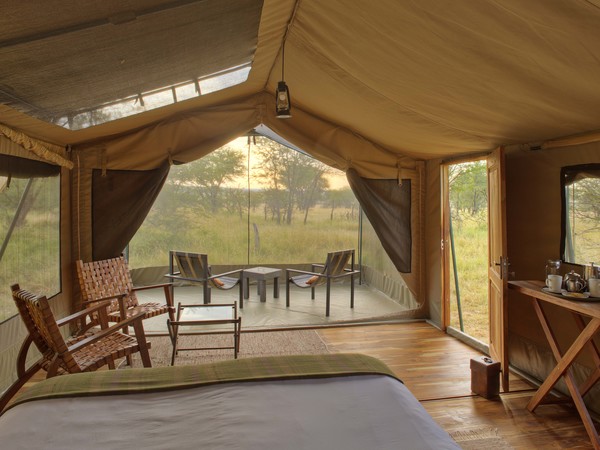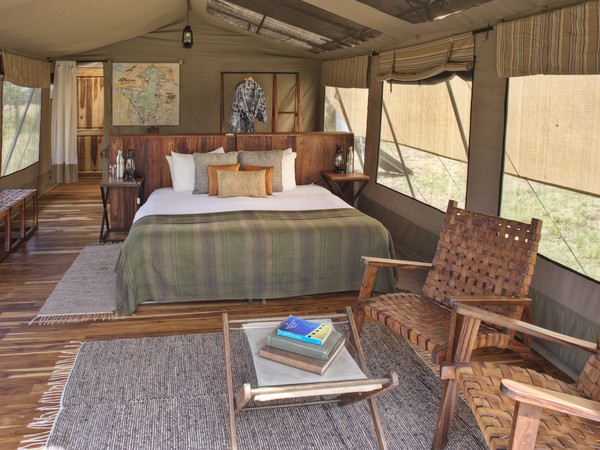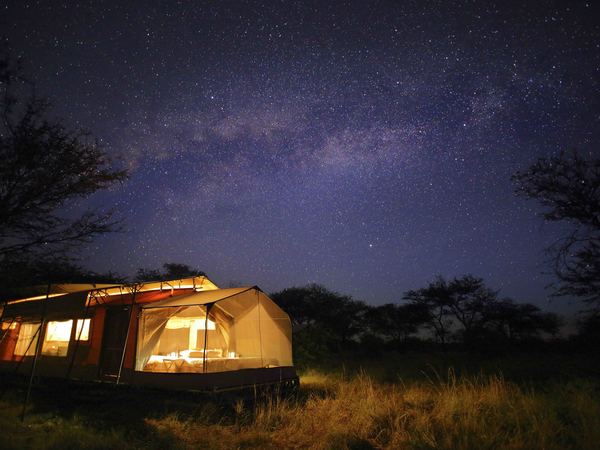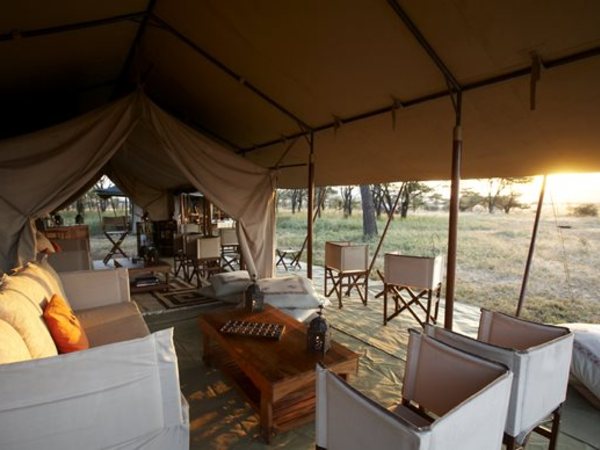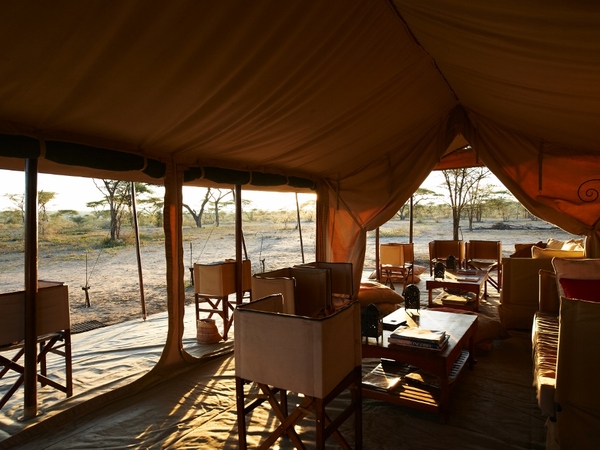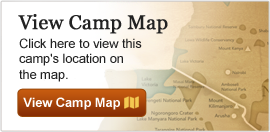Olakira Migration Camp
traditional Camp | Serengeti Nat'l Park, Tanzania
Click here to be the first to review Olakira Migration Camp
Olakira Camp is a wandering base for viewing the great wildebeest migration throughout the seasons. This gracious, luxury mobile tented camp is positioned perfectly in the Ndutu region while the herds congregate there to drop their young, and then moves north in proximity of the Mara River when the herds begin to cross these crocodile-filled waters to seek fresh grass in the northern Serengeti and Maasai Mara. Guests at Olakira always have a front-row seat on the action!

Our Expert Says
Olakira offers the perfect balance of comfort, luxury and traditional mobile-style camping. The camp moves with the migration, offering the best location for viewing the herds throughout the year.
– Megan Bryant

The Camp
Location: Serengeti National Park, Tanzania
Number of Tents: 9
Olakira Camp includes nine impressive Meru-style tents, each spaced well apart with an en suite bathroom featuring a plumbed shower, double washbasins and flushing "loo." The rooms are very spacious, with twin or king beds bedecked in fine linens, wood plank floors, cozy rugs, wooden writing desks, and a screened sitting area for relaxing with a book between safari activities. The front of the tent becomes a fully screened stargazing tent—simply roll your bed into the 270-degree view stargazing tent for a night under the stars while in the comfort of your tent. The central guest area consists of a lounge tent with comfortable sofas and chairs, floor cushions, and a small library of books and traditional African games. The dining tent can be set for communal family-style dining or private tables. Bush meals are encouraged and planned as often as possible, as weather permits. The ambience of the camp evokes a spirit of exploration while maintaining an incredible level of comfort.

Facilities & Amenities
- En suite bathroom with indoor shower
- Shampoo, conditioner and soap
- 220v charging outlets in main area
- In-room safe
- Wi-Fi in main area
- Laundry included
- Local drinks included (house alcoholic and non-alcoholic drinks)
- Credit cards accepted (Visa and MasterCard)
- No air conditioning, hair dryer, telephone or cellular coverage

Wildlife Viewing & Activities
With the Serengeti at your doorstep – all around you, in fact – wildlife viewing from Olakira is optimal. From December to the end of March, the camp is positioned within the Ndutu region of the Ngorongoro Conservation Area on the short-grass plains, where the wildebeest herds gather to drop their young. Morning and afternoon wildlife drives showcase a menagerie of wildebeest, zebra, gazelle, predators, birds and tremendous numbers of plains game. The camp closes during the rains of April and May and re-opens from June to mid-November in the northern Serengeti, just 300 yards from a crossing point on the Mara River. During this time, the wildebeest and zebra herds follow one another across the treacherous, crocodile-filled waters to seek fresh grasses. In the northern Serengeti, morning and afternoon drives are conducted in hopes of viewing the migration and resident species. Balloon safaris are available at additional cost throughout the year.
During the famous Great Migration, the wildebeest can be found dropping their young in the southern Serengeti between December and March, and are typically found attempting to cross the Mara River in the northern Serengeti between July and October. The resident wildlife in the park is found year-round. Other typical sightings may include jackal, warthogs and a number of other mammals, birds and reptiles. Exact sightings will depend on rain patterns and wildlife movements.
| Country | Park/Reserve |
Black Rhino
|
Buffalo
|
Cheetah
|
Eland
|
Elephant
|
Gemsbok / Oryx
|
Giraffe
|
Hippo
|
Hyena
|
Leopard
|
Lion
|
Wildebeest
|
Zebra
|
|
|---|---|---|---|---|---|---|---|---|---|---|---|---|---|---|---|
| Tanzania | Serengeti Nat'l Park |
| Usually viewed | Frequently viewed | Occasionally viewed | Sporadically viewed | Rarely to never viewed |
Climate
| Month | Max | Min | Rainfall |
|---|---|---|---|
| January | 81° F | 64° F | 2.2 in |
| 27° C | 17° C | 56 mm | |
| February | 82° F | 64° F | 2.28 in |
| 27° C | 17° C | 58 mm | |
| March | 82° F | 68° F | 4.49 in |
| 27° C | 20° C | 114 mm | |
| April | 81° F | 64° F | 6.81 in |
| 27° C | 17° C | 173 mm | |
| May | 81° F | 64° F | 4.21 in |
| 27° C | 17° C | 107 mm | |
| June | 81° F | 63° F | 0.98 in |
| 27° C | 17° C | 25 mm | |
| July | 81° F | 63° F | 0.79 in |
| 27° C | 17° C | 20 mm | |
| August | 81° F | 54° F | 0.79 in |
| 27° C | 12° C | 20 mm | |
| September | 82° F | 68° F | 0.98 in |
| 27° C | 20° C | 25 mm | |
| October | 82° F | 64° F | 1.42 in |
| 27° C | 17° C | 36 mm | |
| November | 82° F | 64° F | 2.72 in |
| 27° C | 17° C | 69 mm | |
| December | 81° F | 64° F | 2.6 in |
| 27° C | 17° C | 66 mm |

Conservation
As a mobile camp, Olakira has a very gentle footprint. The camp is moved twice a year and leaves no trace. With every effort made to be carbon-neutral, Olakira compensates for all fossil-fuel emissions through a community reforestation program. The camp is a dedicated supporter of the Rhino Repatriation Program in the Serengeti, and all of the Olakira guides and drivers have been trained by the Frankfurt Zoological Society to identify the individual rhinos in the northern Serengeti and participate in ongoing research by reporting and recording all individuals found in this area. The camp also supports the renowned Serengeti Lion Project, conducted by the University of Minnesota, through funding and support of the researchers.
Reviews for Olakira Migration Camp
Review Olakira Migration Camp No reviews for Olakira Migration Camp Click here to be the first to review Olakira Migration Camp